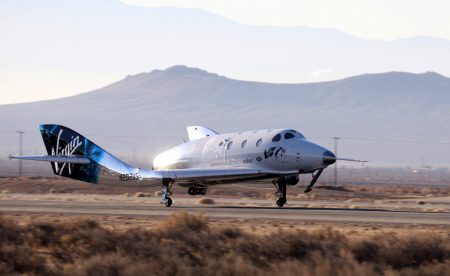December 14, 2018 – The commercial space race witnessed Virgin Galactic’s reentry into the competition yesterday with the flight of SpaceShipTwo. Launched from the WhiteKnightTwo mothership, VSS Unity fired up its rocket engine with two pilots aboard rising from 14.3 kilometers (43,000 feet) to 82 kilometers (just over 50 miles or 271,000 feet) above the Earth’s surface. This is technically not the edge of space which is considered to be 115 kilometers (over 71 miles or 380,000 feet). But it was considered good enough for Branson to claim success in the relaunch of what he hopes will become a commercial space tourism success.
Virgin Galactic has been waiting for this moment for a number of years since the accident that caused SpaceShipTwo’s predecessor, VSS Enterprise, to crash in October of 2014 killing one of the test crew. At the time of the accident it was thought that the rocket engine and fuel being used by Virgin Galactic was responsible for the failure. But it turned out that an error that unlocked a crucial control system was the incident that led to the fatal crash. The pilot and co-pilot were not wearing pressure suits or oxygen masks during the flight since it was a lower altitude test ascending to 18 kilometers (approximately 60,000 feet). This lack of precaution meant that both had no more than 5 seconds to react to the sudden change in the flight of the spaceship before losing consciousness. Only the pilot was able to react, eject, and parachute to safety. The co-pilot was found in the wreckage.
At the time of the crash, Branson wrote, “I found myself questioning seriously for the first time, whether in fact, it was right to be backing the development of something that could result in such tragic circumstances…In short – was Virgin Galactic and everything it has stood for and dreamt of achieving, really worth it?” But yesterday saw a far different Branson who pledged that Virgin Galactic’s space tourism business will be up and running “within months, not years.”
The company has a backlog of some 600 plus passengers who have put down $250,000 to fly on VSS Unity in the coming months. The spaceship can take 6 passengers on each trip to the edge of space reaching a top speed of 4,000 kilometers (just under 2,500 miles) per hour. Once commercial flights begin each flight will reach 110 kilometers (68 miles or 360,000 feet) giving those on board the opportunity to experience weightlessness for several minutes before reentry and an unpowered runway landing at the company’s spaceport in New Mexico.
Branson’s two commercial rivals to send people into space are Jeff Bezos and Elon Musk. Bezos’ Blue Origin, is planning to fly people into space beginning in 2019 using the New Shepard rocket topped by a capsule capable of holding 6 paying customers on board. The New Shepard launches are far more conventional than Virgin Galactic’s technology and Bezos has stated each of his paying customers (no prices announced as of yet) will have to undergo a couple of days training before their flights.
Musk’s SpaceX is one of two commercial companies that will take over ferrying NASA-trained astronauts to the International Space Station in 2019. It has announced it intends to launch a commercial flight to circle the Moon as early as 2023 using its next-generation rocket, the BFR, now renamed the Starship.









